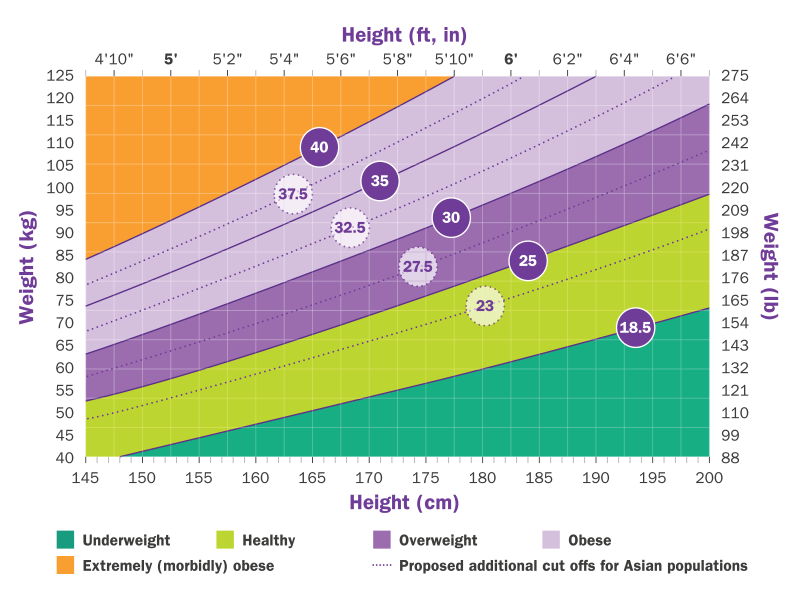A Guide to Body Mass Index
Body mass index, or BMI, is a widely used technique to measure the status of an individual’s metabolic health. Calculating BMI is a relatively simple process that can help a person to better understand how their body weight may be affecting both their physical and mental health, and what their future risk of disease might be.
Bodyweight has long been a rudimentary marker of a person’s health profile, albeit with different implications. Going back to the start of the millennia, famines were a regular occurrence in the UK and continues up to around the mid-1700s (around the beginning of the industrial revolution). During these times, being overweight was associated with a higher socio-economic status. Those that had the wealth to afford rich and wholesome foods were keen to showcase this to others through their waistlines. Today, society conforms to a very different ideal of body image, with thinner, leaner, and more muscular physiques generally being favoured. This is also supported by the overwhelming scientific evidence that exists around the risks of being overweight or obese.
According to data collected from the Health Survey for England (2019), around 36.2% of adults are classified as overweight and 28% are obese. This means that over 50% of adults in the UK are classified as either overweight or obese according to their BMI.

What is BMI?
BMI is an anthropometric value that is calculated based on the relationship between a person’s height and weight. Broadly speaking, the heavier an individual is relative to their height, the greater the risk to their health. For individuals, BMI can often be a powerful indicator that they may need to alter their lifestyle, especially with regards to exercise, physical activity and diet.
Exercise professionals, like fitness instructors and personal trainers, will also need to understand what BMI is and the factors that influence it, so that they are better able to support their clients with bodyweight and body composition goals. BMI will also help exercise professionals to assess their client’s risk of a range of health conditions and diseases (e.g. high blood pressure, heart disease, stroke, type 2 diabetes).
To calculate BMI, an individual will need to measure their height (metres) and weight (kg). Height is usually measured using a stadiometer, which are available in most gyms and health clubs. Alternatively, a tape measure can be used inside a door frame if access to a health club is limited. Weight can be measured using a set of bathroom scales, although it’s important that these are calibrated to ensure accuracy.

BMI and Disease Risk BMI is widely used by healthcare professionals as an indirect indicator of potential future health risks, especially those relating to the cardiovascular system, like high blood pressure, heart disease and strokes. It is an indirect indicator because it doesn’t actually measure the anatomical and physiological markers it is profiling risk for (e.g. blood pressure, cholesterol).
There are a number of medical conditions and diseases that are positively correlated with higher BMI values, including:
- Heart disease
- Stroke
- Type 2 diabetes
- Cancer (kidney, pancreatic, breast, ovarian, liver amongst others)
- Sleep apnea
- Fatty liver disease
- Kidney disease
Medical professionals would usually recommend coupling a healthy diet with a programme of regular physical activity and exercise in order to reduce bodyweight, especially in those individuals that are classified as overweight or obese. In some situations, patients may be referred to an exercise referral programme where they can receive expert advice on exercise and physical activity interventions by an appropriately qualified fitness professional.
Calculating BMI
To calculate BMI, divide bodyweight in kilograms by height in metres squared. The BMI equation is as follows:
BMI = weight (kg) / height m²
Alternatively, you can use the following BMI calculator:
Refer to the classifying BMI section below for more information on what this number means.
Classifying BMI
For adults, the ideal BMI is between 18.5 to 24.99. The bullets below provide a summary of the BMI classification ranges. Again, this data is intended only for use with adults.
- A BMI of 18.49 and below = underweight
- A BMI of 18.5 to 24.99 = ideal weight
- A BMI of 25 to 29.99 = overweight
- A BMI of 30 and above = obese
A visual representation of this data is also provided in the chart below:
Limitations of BMI
Although BMI is frequently used by health and sports professionals as an indirect measure of metabolic health, the calculation does have a number of potential flaws and drawbacks. It would therefore be prudent to use this formula alongside other measures and markers of metabolic health, including percentage of body fat (body composition) and body circumferences (e.g. waist-to-hip ratio) to reach a more reliable conclusion.
The BMI calculation cannot be used to reverse engineer an ideal bodyweight. It is important also to recognise that the equation literally only focuses on body mass/weight and height. It does not consider other factors that may influence an individual’s weight, including:
- Body type – endomorph, ectomorph, mesomorph.
- Body composition – percentage of body fat (fat mass vs. fat free mass).
- Bone density – greater bone density would increase bodyweight.
- Gender – men typically carry more lean muscle tissue than women and would therefore naturally be heavier.
- Age – adults will usually lose lean muscle tissue as they age in response to hormone profile changes.
- Exercise/physical activity profile – those who perform lots of exercise, especially resistance training, will usually have higher levels of muscularity and therefore a greater body weight. This would increase their BMI, but not necessarily their future health risks.
As previously stated, the BMI calculation does not distinguish between muscle and fat, which would present as a disadvantage to those individual’s that have more muscular frames. A pound of fat and a pound of muscle obviously weigh the same. However, muscle tissue is denser than fat tissue and so based on surface area and volume, it is heavier. This would present as a disadvantage in the BMI calculation because any additional weight would automatically be assumed to increase the future risk of future disease. This is very often the case with athletes and gym enthusiasts who according to their BMI classification, are considered to be overweight or obese when in fact they are quite healthy and just slightly more muscular.
A Brief History of BMI
The BMI calculation used today was conceived over 200 years ago by the Belgian astronomer, mathematician, statistician and sociologist, Adolphe Quetelet. Originally dubbed the ‘Quetelet Index’, it was primarily used throughout the 1700’s in Quetelet’s scientific quest to define the physical characteristics of the ‘average’ man. It wasn’t until the early 1900’s that BMI calculation started to be considered by the scientific community as a valid and reliable measure of metabolic health.
In 1972, researcher and nutritionist, Ancel Keys coined the phrase ‘body mass index’ in his paper ‘Indices of Relative Weight and Obesity’ in the Journal of Chronic Diseases. Essentially, he used the Quetelet Index as a means of providing data to evidence that a relationship exists between a person’s height, weight and health status.
Since then, the BMI calculation has grown in popularity and is today widely used by individuals and health care professionals alike to monitor their bodyweight and disease risk status.


